Französisch-Guayana |
|
|
|
| Übersicht – Contents: | |
Diese Seite ist Teil des Projektes
Französisch-Guayana |
|
|
|
| Übersicht – Contents: | |
Flaggen – Flags: |
|
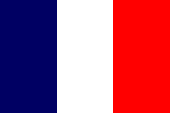 |
die Flagge
Frankreichs |
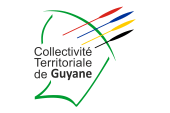 |
seit /since 2015, |
historische Flagge – historical Flag: |
|
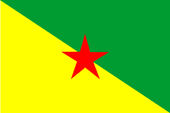 |
2010-2015(?), |
inoffizielle Flaggen – unofficial Flags: |
|
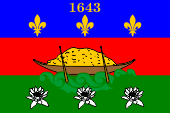 |
inoffizielle Wappenflagge |
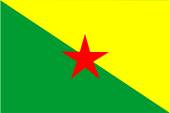 |
angebliche Flagge der Unabhängigkeitsbewegung |
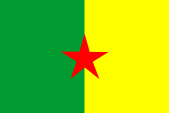 |
Flagge der / flag of the |
| Alle französischen Kolonien, hatten über lange Zeit keine eigene Flagge. Es musste die französische Trikolore gehisst werden. Das gilt im Prinzip bis heute. Der Status der Kolonien änderte sich über die Jahre. Einige sind heute Überseedepartements, und damit ein ultraperipherischer Teil Frankreichs und auch der EU; andere sind Überseegemeinschaften, die autonom sind, und nicht Teil Frankreichs oder der EU. Überseedepartements gehören – nicht wie die Departements des Mutterlandes – zu keiner administrativen Region Frankreichs, sondern bilden eine eigene Region. |
All French colonies had no own flag over a long period. It had to be hoisted the French tricolor. This in principle usual until today.
The status of the colonies changed over the years. Some of them are now overseas departments, and thus a ultraperipheric part of France and of the EU; others are overseas communities, autonomous, and not a part of France or the EU. Overseas departments belong – in contrast to the departments of the motherland – to no administrative region of France, they are a separate region. |
| Die Gebietskörperschaft muss demzufolge offiziell die Flagge Frankreichs verwenden, jedoch können der Generalrat als oberstes gewähltes Kollegialorgan eines französischen Départements und auch der Regionalrat als oberstes gewähltes Kollegialorgan einer französischen Region eigene Flaggen haben. | The territorial entity has therefore officially to use the flag of France. However, the General Council as the highest elected collegial body of a French Department and the Regional Council as the highest elected collegial body of a French Region can have their own flags. |
| Diese Départements- und Regionsflaggen haben allerdings oft das Erscheinungsbild von Firmenflaggen mit Logos oder gar stilisierten Bildern, wirken lieblos, unhistorisch, technokratisch und modernistisch, denn im streng zentralistischen Frankreich wird jedwede Regionalität oder gar ein Bezug zur Geschichte vermieden. Darum sind diese Regions-Logo-Flaggen unbeliebt und werden kaum benutzt. | These flags of departments and regions, however, have oftenly the appearance of company flags with logos or even stylized images, appear carelessly, ahistorical, technocratic and modernist, because in the strictly centralist France is avoided any regionalism or even a historical subscription. Because of that these logo flags of regions are unpopular and are rarely used. |
| Neben der Tikolore darf seit 2010 die Flagge des "Département d'Outre-Mer de la Guyane Française" gehisst werden, seit 2015 wahrscheinlich die neu geschaffene Flagge der Gebietskörperschaft. | Next to the Tricolour, the flag of the "Département d'Outre-Mer de la Guyane Française" has been allowed to be hoisted since 2010, and than probably the newly created flag of the territorial community since 2015. |
| Der Generalrat des Departements hatte (als Verwaltungsorgan) seine eigene Flagge, genau so wie der Regionalrat der Region (als höheres Verwaltungsorgan). Diese Flaggen wurden am 29.01.2010 von einer neuen Flagge ergänzt, die das Departement als Gebietskörperschaft repräsentierte. Sie war diagonal geteilt. Das obere Dreieck im wehenden Ende war grün, das untere Dreieck am Liek war gelb. In der Mitte war ein roter, fünfzackiger Stern platziert. Das Grün stand für den Wald, das Gelb (Gold) für die Bodenschätze des Landes. Der rote Stern symbolisierte das „Blut im Herzen des Landes“. Diese Flagge war eigentlich die Flagge der UTG, der größten Gewerkschaft des Landes, jedoch offiziell erst seit November 2004. Erstmals benutzt wurde diese Flagge jedoch schon 1967. Mit einer Verwaltungsreform im Jahre 2015 wurden Generalrat und Regionalrat zusammeglegt, die Gebietskörperschaft erhielt den Status einer "Collectivité territoriale unique" und es wurde eine Flagge für die Gebietskörperschaft angenommen. Das ist eine weiße Logo-Flagge modernistischen Zuschnitts mit der Silhouette des Landes, bunten Lanzenspitzen und einer Inschrift. | The General Council of the Department (as an administrative body) had its own flag, as did the Regional Council of the Region (as a higher administrative body). These flags were complemented on 29th of January in 2010 by a new flag representing the department as a territorial collectivity. It was divided diagonally. The upper triangle in the waving end was green, the lower triangle at the mast side was yellow. A red, five-pointed star was placed in the middle. The green stood for the forest, the yellow (gold) for the country's mineral resources. The red star symbolised the "blood in the heart of the country". This flag was actually the flag of the UTG, the largest trade union in the country, but officially only since November 2004. However, this flag was first used in 1967. On the occasion of an administrative reform in 2015, the General Council and the Regional Council were merged, the territorial entity was given the status of a "Collectivité territoriale unique" and a flag was adopted for that territorial entity. It is a white logo-flag of modernist design with the silhouette of the country, colourful lance points and an inscription. |
| Für lokale und touristische Zwecke gibt es jedoch – wie bei fast allen französischen Besitzungen üblich – noch die bekannten und beliebten Wappen-Flaggen. Dazu wird das Bild des Wappenschilds des Landes auf ein Flaggentuch übertragen. | But, there exist, for local and tourist purposes – usual in almost all French possessions - the famous and popular crest flags, where the image of the Coat of Arms of the country is transferred to a bunting. |
| Eine weitere Flagge, die – zumindest im Internet – häufig zu finden ist, ist die Flagge der Unabhängigkeitsbewegung. Sie ähnelt der Flagge des Departements, jedoch sind das grüne und gelbe Feld getauscht. Wahrscheinlich war in Wirklichkeit eine senkrechte Teilung der Flagge zwischen Grün und Gelb gemeint, denn eine solche Flagge – auch mit Stern – ist die Flagge der "Tam-Tam Front pour la Liberation de Guiana". |
Another flag, which is often to see – at least on the web – is the flag of the independence movement. It is similar to the flag of the department, but the green and yellow fields are exchanged. Probably in reality was seen a vertical division of the flag between green and yellow, because such a flag – also with the red star - is the flag of the "Tam-Tam Front pour la Liberation de Guiana". |
| Die Farbenkombination von Grün, Gelb und Rot sind die Panafrikanischen Farben: Etwa 1900 setzte die Panafrika-Bewegung ein, die Gemeinsamkeiten aller Menschen mit schwarzer Hautfarbe hervorheben wollte. 88% der Bevölkerung von Französisch-Guayana sind Schwarze und Mulatten. Der Farbendreiklang Grün-Gelb-Rot, den viele afrikanische und auch amerikanische Staaten nach Erlangung ihrer Unabhängigkeit in ihre Flaggen übernahmen, steht für die politische Einheit Afrikas, ja aller Schwarzen. Das erste Land war Ghana im Jahr 1957. Als Ursprung gelten die Landesfarben von Athiopien (Abessinien), dem ältesten unabhängigen Staat Afrikas. Die Farben der Flagge der Unabhängigkeitsbewegung von Französisch-Guayana finden sich so auch in der Flagge des brasilianischen Bundesstaats Acre. | The
combination of the colours green, yellow and red is called the Panafrican
Colours: Perhaps in 1900 was the beginning of the Panafrica-Movement, wich wants to emphasize the commons of all people with black skin. 88% of the population of French Guyana are Blacks and Mulattoes. The colour-triad green-yellow-red, wich is used by many african and even american countries in their flags after the independence, stands for the political unity of Africa, of all black people. The first country was Ghana in 1957. As the origin apply the colours of Ethiopia (Abessinia), the oldest independent state in Africa. The colours of the flag of the independence movement of French Guiana is to see as well in the flag of the Brazilian federal state of Acre. |
| Quelle/Source: Wikipedia (D), Volker Preuß | |
| Wappen – Coat of arms: | |
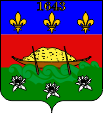 |
Wappen von Französisch-Guayana – coat of arms of French Guiana, Quelle/Source, nach/by: Wikipedia (D) |
| Das Wappen von Französisch-Guayana ist das Wappen der Hauptstadt Cayenne. Das Wappenschild ist zweimal geteilt und zeigt oben in Blau drei goldene Lilien, darüber die goldene Jahreszahl 1643. Mittig in Rot ein Boot mit zwei Riemen und einen Haufen Gold, und unten in Grün drei natürliche silberne Seerosen. Die goldenen Lilien beziehen sich auf Frankreich, die Jahreszahl auf die Gründung von Cayenne. Das Gold in dem Boot soll den Reichtum der Region symbolisieren. | The coat of arms of French Guiana is the
coat of arms of the capital Cayenne. The shield is divided twice and shows above in blue three golden lilies, above in gold the date of 1643. Centered in red a boat with two oars and a heap of gold, and below in green three natural silvery water lilies. The golden lilies refer to France, the date to the foundation of Cayenne. The gold in the boat should symbolizes the richness of the region. |
| Quelle/Source: Wikipedia (D) | |
| Landkarte – Map: |
|
| Zahlen und Fakten – Numbers and Facts: | |
|
|
|
|
|
|
|
|
|
|
|
|
|
|
|
|
|
|
| Quelle/Source: Wikipedia (D), Länder der Erde | |
|
1498 · von Kolumbus entdeckt 1604 · Beginn der französischen Kolonisierung 1643 · Gründung von Cayenne 1816 · Grenzverträge mit den Nachbarn 1848 · Aufhebung der Sklaverei 1852–1946 · Guayana ist französische Strafkolonie 1946 · Französisch-Guayana wird Überseedepartement 2015 · Verwaltungsreform, Generalrat und Regionalrat werden zusammengelegt, das Land wird eine "Collectivité territoriale unique" |
|
1498 · discovered by Columbus 1604 · start of the French Colonization 1643 · foundation of Cayenne 1816 · frontier-contracts with the neighbours 1848 · abolition of the slavery 1852–1946 · Guiana is a French penal colony 1946 · French Guiana becomes a overseas department 2015 · administrative reform, General Council and Regional Council are merged, the country becomes a "Collectivité territoriale unique" |
| Quelle/Source: Wikipedia (D) |
| Der Name "Guayana" (auch Guyana) stammt wahrscheinlich aus den Indianischen Sprachen, und es gibt zwei Erklärungen: 1.) ehrenwert, 2.) viel Wasser. | The name "Guyana" (also Guyana, Guiana) comes probably from the Indian languages, and there exist two explanations: 1st) honorable, 2nd) lot of water. |
| Quelle/Source: Atlas der wahren Namen | |